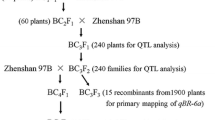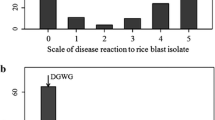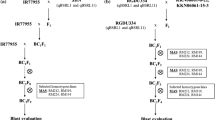Abstract
SHZ-2 is an indica rice cultivar that exhibits broad-spectrum resistance to rice blast; it is widely used as a resistance donor in breeding programs. To dissect the QTL responsible for broad-spectrum blast resistance, we crossed SHZ-2 to TXZ-13, a blast susceptible indica variety, to produce 244 BC4F3 lines. These lines were evaluated for blast resistance in greenhouse and field conditions. Chromosomal introgressions from SHZ-2 into the TXZ-13 genome were identified using a single feature polymorphism microarray, SSR markers and gene-specific primers. Segregation analysis of the BC4F3 population indicated that three regions on chromosomes 2, 6, and 9, designated as qBR2.1, qBR6.1, and qBR9.1, respectively, was associated with blast resistance and contributed 16.2, 14.9, and 22.3%, respectively, to the phenotypic variance of diseased leaf area (DLA). We further narrowed the three QTL regions using pairs of sister lines extracted from heterogeneous inbred families (HIF). Pairwise comparison of these lines enabled the determination of the relative contributions of individual QTL. The qBR9.1 conferred strong resistance, whereas qBR2.1 or qBR6.1 individually did not reduce disease under field conditions. However, when qBR2.1 and qBR6.1 were combined, they reduced disease by 19.5%, suggesting that small effect QTLs contribute to reduction of epidemics. The qBR6.1 and qBR9.1 regions contain nucleotide-binding sites and leucine rich repeats (NBS-LRR) sequences, whereas the qBR2.1 did not. In the qBR6.1 region, the patterns of expression of adjacent NBS-LRR genes were consistent in backcross generations and correlated with blast resistance, supporting the hypothesis that multiple resistance genes within a QTL region can contribute to non-race-specific quantitative resistance.





Similar content being viewed by others
References
Ashikawa I, Hayashi N, Yamane H, Kanamori H, Wu JZ, Matsumoto T, Ono K, Yano M (2008) Two adjacent NBS-LRR class genes are required to confer Pikm-specific rice blast resistance. Genetics 180:2267–2276
Bai JF, Pennill LA, Ning JC, Lee SW, Ramalingam J, Webb CA, Zhao BY, Sun Q, Nelson JC, Leach JE, Hulbert SH (2002) Diversity in nucleotide binding site—leucine-rich repeat genes in cereals. Genome Res 12:1871–1884
Ballini E, Morel JB, Droc G, Price A, Courtois B, Notteghem JL, Tharreau D (2008) A genome-wide meta-analysis of rice blast resistance genes and quantitative trait loci provides new insights into partial and complete resistance. Mol Plant Microbe Interact 21:859–868
Ballini E, Vergne E, Tharreau D, Notteghem JL, Morel JB (2009) ARCHIPELAGO: towards bridging the gap between molecular and genetic information in rice blast disease resistance. In: Wang GL, Valent B (eds) Advances in genetics, genomics and control of rice blast disease. Springer, Netherlands, pp 417–425
Bryan GT, Wu KS, Farrall L, Jia YL, Hershey HP, McAdams SA, Faulk KN, Donaldson GK, Tarchini R, Valent B (2000) A single amino acid difference distinguishes resistant and susceptible alleles of the rice blast resistance gene Pi-ta. Plant Cell 12:2033–2045
Carrillo MGC, Goodwin PH, Leach JE, Leung H, Vera Cruz CM (2009) Phylogenomic relationships of rice oxalate oxidases to the cupin superfamily and their association with disease resistance QTL. Rice 2:67–79
Chen DH, Zeigler RS, Leung H, Nelson RJ (1995) Population structure of Pyricularia grisea at two screening sites in the Philippines. Phytopathology 85:1011–1020
Edwards JD, Janda J, Sweeney MT, Gaikwad AB, Liu B, Leung H, Galbraith DW (2008) Development and evaluation of a high-through, low-cost genotyping platform based on oligonucleotide microarrays in rice. Plant Methods 4:13
Fjellstrom R, Conaway-Bormans CA, McClung AM, Marchetti MA, Shank AR, Park WD (2004) Development of DNA markers suitable for marker assisted selection of three Pi genes conferring resistance to multiple Pyricularia grisea pathotypes. Crop Sci 44:1790–1798
International Network for Genetic Evaluation of Rice (1996) Standard evaluation system for rice, 4th edn. International Rice Research Institute, Los Banos, Laguna, Philippines, p 52
Jeon JS, Chen D, Yi GH, Wang GL, Ronald PC (2003) Genetic and physical mapping of Pi5 (t), a locus associated with broad-spectrum resistance to rice blast. Mol Genet Genomics 269:280–289
Jia YL, Wang ZH, Singha P (2002) Development of dominant rice blast Pi-ta resistance gene markers. Crop Sci 42:2145–2149
Johnson R (1981) Durable resistance: definition of, genetic control, and attainment in plant breeding. Phytopathology 71:567–568
Lee SK, Song MY, Seo YS, Kim HK, Ko S, Cao PJ, Suh JP, Yi G, Roh JH, Lee S, An G, Hahn TR, Wang GL, Ronald P, Jeon JS (2009) Rice Pi5-mediated resistance to Magnaporthe oryzae requires the presence of two coiled-coil-nucleotide-binding-leucine-rich repeat genes. Genetics 181:1627–1638
Lin F, Liu Y, Wang L, Liu X, Pan QH (2004) A high-resolution map of the rice blast resistance gene Pi15 constructed by sequence-ready markers. Plant Breed 126:287–290
Liu B, Zhang SH, Zhu XY, Yang QY, ShZh Wu, Mei MT, Mauleon R, Leach JE, Mew T, Leung H (2004) Candidate defense genes as predictors of quantitative blast resistance in rice. Mol Plant Microbe Interact 17:146–152
Liu B, Zhu XY, Zhang SH, Wu JL, Han SS, Cho YC, Roh JH, Leach JE, Liu Y, Madamba S, Bordeos A, Baraoidan M, Oña I, Vera Cruz CM, Leung H (2009) What it takes to achieve durable resistance to rice blast? In: Wang GL, Valent B (eds) Advances in genetics, genomics and control of rice blast disease. Springer, Netherlands, pp 385–402
Liu J, Wang X, Mitchell T, Hu Y, Liu X, Dai LY, Wang GL (2010) Recent progress and understanding of the molecular mechanisms of the rice-Magnaporth oryzae interaction. Mol Plant Pathol 11:419–427
Manosalva PM, Davidson RM, Liu B, Zhu XY, Hulbert SH, Leung H, Leach JE (2009) A germin-like protein gene family functions as a complex quantitative trait locus conferring broad-spectrum disease resistance in rice. Plant Physiol 149:286–296
McCouch SR, CGSNL (2008) Gene nomenclature system for rice. Rice 1:72-84
Meyers BC, Dickerman AW, Michelmore RW, Sivaramakrishnan S, Sobral BW, Young ND (1999) Plant disease resistance genes encode members of an ancient and diverse protein family within the nucleotide-binding superfamily. Plant J 20:317–332
Murray MG, Thompson WF (1980) Rapid isolation of high molecular weight plant DNA. Nucl Acids Res 8:4321–4325
Notteghem JL, Chatel M, Dechanet RD (1981) Analyze of two characteristics of rice resistance to Pyricularia oryzae. In: Comptes-rendus du symposium sur la resistance du riz a la pyriculariose. IRAT-GERDAT, Montpellier, France, pp 301–318
Perchepied L, Kroj T, Tronchet M, Loudet O, Roby D (2006) Natural variation in partial resistance to pseudomonas syringae is controlled by two major QTLs in Arabidopsis thaliana. PLoS One 1(123):1–10
Raghavan C, Naredo MEB, Wang HH, Atienza G, Liu B, Qiu FL, McNally KL, Leung H (2007) Rapid method for detecting SNPs on agarose gels and its application in candidate gene mapping. Mol Breed 19:87–101
Richly E, Kurth J, Leister D (2002) Mode of amplification and reorganization of resistance genes during recent Arabidopsis thaliana evolution. Mol Biol Evol 19:76–84
Shang JJ, Tao Y, Chen XW, Zou Y, Lei CL, Wang J, Li XB, Zhao XF, Zhang MJ, Lu ZK, Xu JC, Cheng ZK, Wan JM, Zhu LH (2009) Identification of a new rice blast resistance gene, Pid3, by genome-wide comparison of paired NBS-LRR genes and their pseudogene alleles between the two sequenced rice genomes. Genetics 182:1303–1311
Song FM, Goodman RM (2001) Molecular biology of disease resistance in rice. Physiol Mol Plant Pathol 59:1–11
Tuinstra MR, Ejeta G, Goldsbrough PB (1997) Heterogeneous inbred family (HIF) analysis: a method for developing near-isogenic lines that differ at quantitative trait loci. Theor Appl Genet 95:1005–1011
Vergne E, Ballini E, Droc G, Tharreau D, Nottéghem JL, Morel JB (2008) Archipelago: a dedicated resource for exploiting past, present, and future genomic data on disease resistance regulation in rice. Mol Plant Microbe Interact 21:869–878
Wang GL, Mackill DJ, Bonman M, McCouch SR, Champoux MC, Nelson RJ (1994) RFLP mapping of genes conferring complete and partial resistance to blast in a durably resistant rice cultivar. Genetics 136:1421–1434
Wang ZX, Yano M, Yamanouchi U, Iwamoto M, Monna L, Hayasaka H, Katayose Y, Sasaki T (1999) The Pib gene for rice blast resistance belongs to the nucleotide binding and leucine-rich repeat class of plant disease resistance genes. Plant J 19:55–64
Wang ZX, Yamanouchi U, Katayose Y, Sasaki T, Yano M (2001) Expression of the Pib gene rice-blast-resistance gene family is up-regulated by environmental conditions favouring infection and chemical signals that trigger secondary plant defense. Plant Mol Biol 47:653–661
Yang JY, Chen S, Zeng LX, Li YL, Chuan-ying Li, Zhu XY (2008) Race specificity of major rice blast resistance genes to Magnaporthe grisea isolates collected from indica rice in Guangdong, China. Rice Sci 15:311–318
Yi G, Lee SK, Hong YK, Cho YC, Nam MH, Kim SC, Han SS, Wang GL, Hahn TR, Ronald PC (2004) Use of Pi5(t) markers in marker-assisted selection to screen for cultivars with resistance to Magnaporthe grisea. Theor Appl Genet 109:978–985
Zhu XY, Yang QY, Huo CB, Wu SZ (1996) Studies on the qualitative and quantitative resistance of rice cultivars to blast disease. Chin J Rice Sci 10:181–184
Zhu XY, Yang QY, Liu B, Zhang SH, Wu SZ (2003) The characteristics of resistance to rice blast of SHZ-2 and its derivative varieties. Guangdong Agric Sci 2:37–40
Acknowledgments
This work was supported in part by grants from the Generation Challenge Program (HL), USDA-NRI (DWG, JEL, HL), USAID Linkage Program grants, the MOST Key International Collaboration Project (2006DFB33320, BL, HL), NSFC-IRRI Project (30821140350, BL, HL), and the Guangdong International Collaboration Project (2007A050100037, BL).
Author information
Authors and Affiliations
Corresponding author
Additional information
Communicated by M. Wissuwa.
Electronic supplementary material
Below is the link to the electronic supplementary material.
Rights and permissions
About this article
Cite this article
Liu, Y., Zhu, X.Y., Zhang, S. et al. Dissecting quantitative resistance against blast disease using heterogeneous inbred family lines in rice. Theor Appl Genet 122, 341–353 (2011). https://doi.org/10.1007/s00122-010-1450-2
Received:
Accepted:
Published:
Issue Date:
DOI: https://doi.org/10.1007/s00122-010-1450-2




